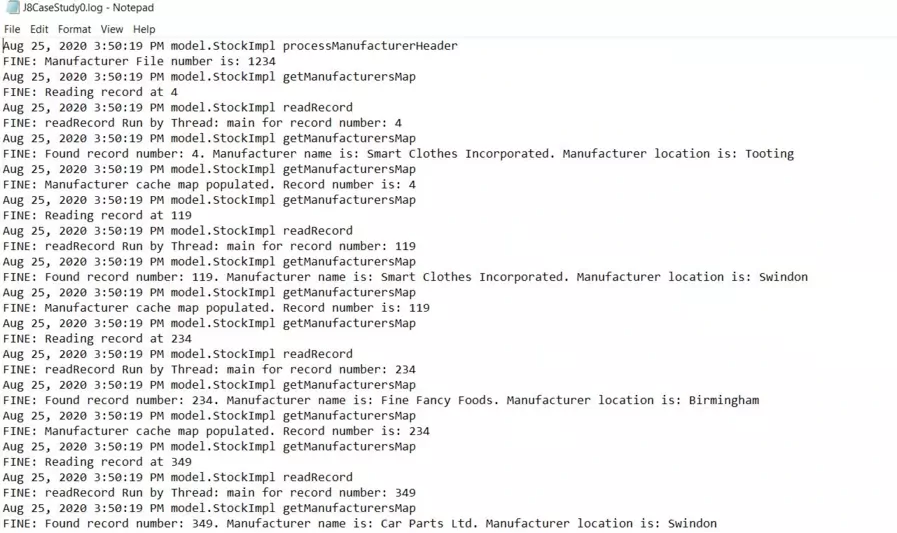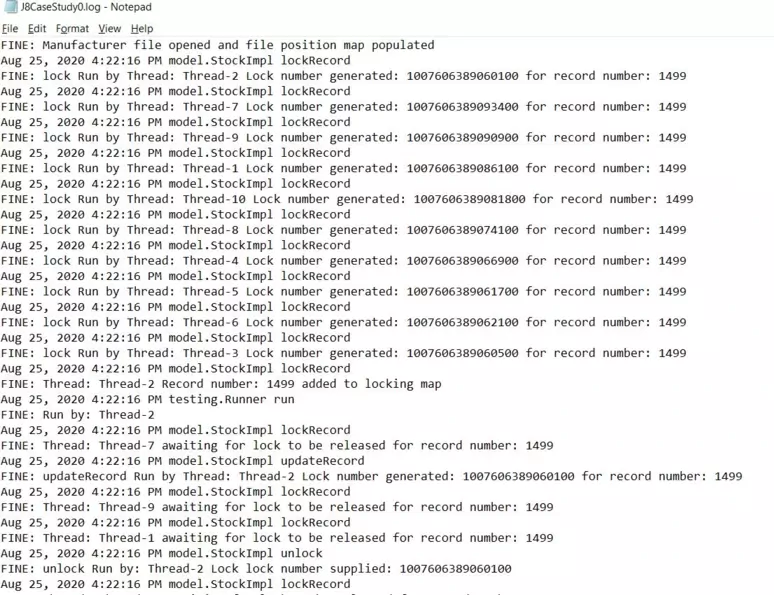Testing - ModelJ8 Home « Testing - Model
In this lesson of the Case Study we do some testing of our Model code. We start by writing a program to test various methods of the StockImpl class which will also test the Manufacturer class in the process. We will write out methods called to a log file and view the logged results, thus also testing that our logging is working as intended. After this we write a test program to validate our locking is functioning correctly.
We start the testing of the model code by writing a program to test various methods of the StockImpl class which will also test the Manufacturer class in the process. We will write out methods invoked to a log file and view the logged results, thus also testing that our logging is working as intended. After this we write a test program to validate our locking functioning is working correctly.
Testing The StockImpl Class Top
Our first test class will test various methods within the StockImpl class including the search, stocking and unstocking functionality requested by the stakeholder Stocking Goods Limited.
Create the TestStockImpl class in the client package and cut and paste the following code into it.
package testing;
import java.util.logging.FileHandler;
import java.util.logging.Level;
import java.util.logging.Logger;
import java.io.IOException;
import java.util.logging.SimpleFormatter;
import model.StockImpl;
import model.StockingException;
/*
* In out first test program we create a logger which we will look at after, so we can
* see the logger working. We then test various methods of the StockImpl
* class that are not tested from the GUI such as creating and deleting Manufacturer
* records, as well as a few other tests which will show our methods working as intended.
*
*/
public class TestStockImpl {
/*
* The Logger instance through which all log messages from this class are routed.
* Logger namespace is J8CaseStudy.
*/
private static Logger log = Logger.getLogger("J8CaseStudy"); // Log output
static String pathname = "D:\\ManufacturerApplication\\src\\manufacturertestfile.txt";
public static void main(String[] args) {
try {
/*
* Setup a rotating file in default user directory for machine that will
* handle logs for the whole application
*/
FileHandler manufacturerFileHandler =
new FileHandler("D:\\ManufacturerApplication\\J8CaseStudy%g.log", 0, 10);
manufacturerFileHandler.setFormatter(new SimpleFormatter());
Logger log = Logger.getLogger("J8CaseStudy");
log.addHandler(manufacturerFileHandler);
log.setLevel(Level.FINE);
// Get StockImpl singleton
StockImpl getInstance = StockImpl.getStockImplInstance(pathname);
// Test search
String[] findArray = {"Fine Fancy Foods", "Chester"};
long[] retRecNos = new long[1];
retRecNos = getInstance.findBySearchCriteria(findArray);
log.fine("Search Criteria 1: record numbers returned: ");
for (int i = 0; i < retRecNos.length; i++) {
if (retRecNos[i] == 0) break;
log.fine("rec Number: " + retRecNos[i]);
}
String[] findArray2 = {"Fine Fancy Foods", null};
long[] retRecNos2 = new long[5];
retRecNos2 = getInstance.findBySearchCriteria(findArray2);
log.fine("Search Criteria 2: record numbers returned: ");
for (int i = 0; i < retRecNos2.length; i++) {
if (retRecNos2[i] == 0) break;
log.fine("rec Number: " + retRecNos2[i]);
}
String[] findArray3 = {null, "Tooting"};
long[] retRecNos3 = new long[5];
retRecNos3 = getInstance.findBySearchCriteria(findArray3);
log.fine("Search Criteria 3: record numbers returned: ");
for (int i = 0; i < retRecNos3.length; i++) {
if (retRecNos3[i] == 0) break;
log.fine("rec Number: " + retRecNos3[i]);
}
// Test manufacturer record creation
String[]
createArray = {" ", "Fine Fancy Foods", "Laindon", "Pyjamas", "12.99", "20", " "};
getInstance.createRecord(createArray);
// Test stocking functionality
getInstance.stocking("Fine Fancy Foods", "Swindon", 10, 10);
// Test unstocking functionality
getInstance.unstocking("Fine Fancy Foods", "Birmingham", 12);
// Test manufacturer record deletion
//Put record number in the locking map
Long recNo = 119L;
Long cookie = getInstance.lockRecord(recNo);
getInstance.deleteRecord(recNo, cookie);
getInstance.unlock(recNo, cookie);
} catch (IOException e) {
e.printStackTrace();
} catch (StockingException e) {
e.printStackTrace();
}
}
public static Logger getLog() {
return log;
}
public static void setLog(Logger log) {
TestStockImpl.log = log;
}
}
Running The Packaged TestStockImpl class
Run the TestStockImpl class from your IDE.
The screenshot below shows some information messages for record creation, stocking and unstocking. To see the program flow and check the search functionality we will need to check the log file.

TestStockImpl class.Checking The Log FileTop
We should now have our first log file created which we will investigate next to see program flow.

If you go to the ManufacturerApplication directory and double click on the log file you should be presented with the program flow thats start something like the screenshot below:

Take some time and investigate the lock and records numbers created for our cache map and check these against the searches we tested for. The functionality is working as expected and the log
file also shows usage of the Manufacturer class.
Testing Record Locking Top
The last thing we are going to test on the model side is record locking and to do this without causing a severe error such as a RecordNotFoundException we are going to run several
threads through a lock-update-unlock cycle to ensure that our locking is working correctly. To do this we are going to code a TestThreads class and another class that implements the
Runnable interface and pass 10 threads through which is more than enough to ensure our locking code is working correctly.
Create the TestThreads class in the testing package and cut and paste the following code into it.
package testing;
import java.util.logging.FileHandler;
import java.util.logging.Level;
import java.util.logging.Logger;
import java.io.IOException;
import java.util.logging.SimpleFormatter;
import model.StockImpl;
class Runner implements Runnable {
/*
* The Logger instance through which all log messages from this class are routed.
* Logger namespace is J8CaseStudy.
*/
private static Logger log = Logger.getLogger("J8CaseStudy"); // Log output
static String pathname = "D:\\ManufacturerApplication\\src\\manufacturertestfile.txt";
public void run() {
log.fine("Entering run method");
// Get StockImpl singleton
StockImpl getInstance = StockImpl.getStockImplInstance(pathname);
// Update locking test
String[] updateArray = {" ", "Fine Fancy Foods", "Laindon", "Pyjamas", "14.99", "20", " "};
//Put record number in the locking map
Long recNo = 1499L;
Long cookie = getInstance.lockRecord(recNo);
log.fine("Run by: " + Thread.currentThread().getName());
getInstance.updateRecord(recNo, updateArray, cookie);
getInstance.unlock(recNo, cookie);
}
}
public class TestThreads {
/*
* The Logger instance through which all log messages from this class are routed.
* Logger namespace is J8CaseStudy.
*/
private static Logger log = Logger.getLogger("J8CaseStudy"); // Log output
static String pathname = "D:\\ManufacturerApplication\\src\\manufacturertestfile.txt";
public static void main(String[] args) {
try {
/*
* Setup a rotating file in default user directory for machine that will
* handle logs for the whole application
*/
FileHandler manufacturerFileHandler =
new FileHandler("D:\\ManufacturerApplication\\J8CaseStudy%g.log", 0, 10);
manufacturerFileHandler.setFormatter(new SimpleFormatter());
Logger log = Logger.getLogger("J8CaseStudy");
log.addHandler(manufacturerFileHandler);
log.setLevel(Level.FINE);
} catch (IOException e) {
e.printStackTrace();
}
Runner rnnr = new Runner();
Thread one = new Thread(rnnr);
Thread two = new Thread(rnnr);
Thread three = new Thread(rnnr);
Thread four = new Thread(rnnr);
Thread five = new Thread(rnnr);
Thread six = new Thread(rnnr);
Thread seven = new Thread(rnnr);
Thread eight = new Thread(rnnr);
Thread nine = new Thread(rnnr);
Thread ten = new Thread(rnnr);
one.start();
two.start();
three.start();
four.start();
five.start();
six.start();
seven.start();
eight.start();
nine.start();
ten.start();
}
public static Logger getLog() {
return log;
}
public static void setLog(Logger log) {
TestThreads.log = log;
}
}
Running The Packaged TestThreads class
Run the TestThreads class from the testing package.
Check Locking Log FileTop
We should now have another log file created which we will lock at to check our locking. The way the log files are set up the most recent file will always be suffixed with 0 so current file is J8CaseStudy0.log
If you click on the log file and lock through it you can see threads being locked, updated and unlocked as you can partly see in the screenshot below:

That concludes our testing for the model side of the case study and of course in the real world you would be a lot more thorough and do more tests than those we have shown here.
Lesson 18 Complete
In this lesson we tested the Model elements of the MVC pattern.
Related Java Tutorials
Fundamentals - Primitive Variables
Fundamentals - Conditional Statements
Fundamentals - Loop Statements
Objects & Classes - Arrays
Objects & Classes - Class Structure and Syntax
Objects & Classes - Reference Variables
Objects & Classes - Methods
Objects & Classes - Instance Variables & Scope
Objects & Classes - Constructors
Objects & Classes - Static Members
Objects & Classes - Enumerations
OO Concepts - Encapsulation
OO Concepts - Inheritance Concepts - Using the super keyword
OO Concepts - Interfaces
Exceptions - Handling Exceptions
API Contents - Inheritance - Using the package keyword
API Contents - Inheritance - Using the import keyword
API Contents - Java I/O Overview - The java.io.File Class
Concurrency - Thread Basics
Concurrency - The Runnable Interface
What's Next?
In the next lesson we test the View elements of the MVC pattern.